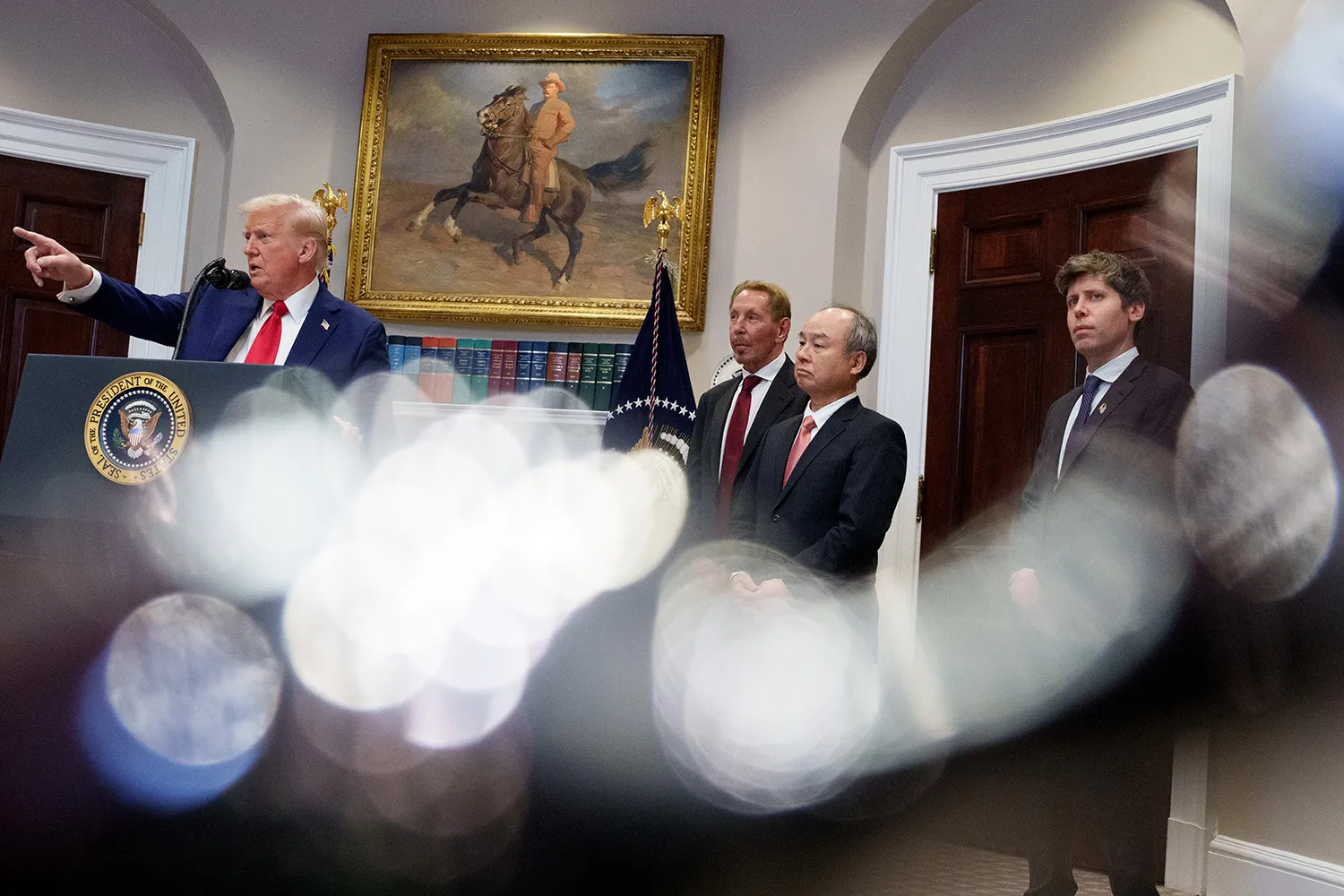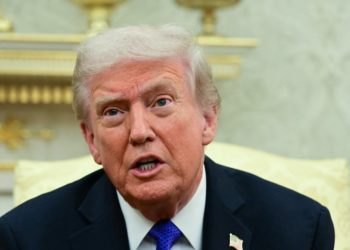The global digital order is being rapidly reshaped under U.S. President Donald Trump. What had previously been an uneasy but functioning framework of cooperation, built on multilateral tech diplomacy, coordinated artificial intelligence safety efforts, and collective export controls, is now unravelling. In its place, the United States is embracing a more unilateral and aggressive technology strategy, prioritizing technological dominance over multilateral cooperation. As the January announcement about the establishment of the President’s Council of Advisors on Science and Technology put it, “it is a national security imperative for the United States to achieve and maintain unquestioned and unchallenged global technological dominance.” The new doctrine is simple: “America First,” in digital form.
Because of this strategy, the global technological landscape is entering a period of heightened competition, fragmentation, and uncertainty. There will be a surge in techno-nationalism and a more dangerous digital landscape. The United States may achieve short-term technological gains, but it will be unable to sustain long-term leadership without a broad coalition of allies and partners. Fragmentation will slow the global pace of innovation while also catalyzing the emergence of new models of governance as states seek more control over their technological future.
The results are immediate. Allies are unsettled. Competitors are adapting. Neutral countries are increasingly seeking a third way that insulates them from both U.S. and Chinese pressure. In an age of techno-nationalism, where control over advanced technology defines strategic power, Washington’s retreat from coalition-building threatens to erode the very influence it seeks to preserve.

The Biden administration placed technology at the center of geopolitical competition. It developed an international technology strategy that relied heavily on coordination and shared values with allies and partners. Washington mobilized collective efforts to shape the global governance of emerging technologies, promote responsible behavior in cyberspace, and defend a free and open internet. It attempted to smooth over (or at least compartmentalize) differing national approaches to regulation, invest in digital-capacity building for global partners, strengthen domestic innovation and supply chain resilience, and slow the flow of technology to competitors, especially China.
This strategy is being replaced with calls for “America First” dominance in emerging technologies, especially AI, and vocal attacks on the European Union’s approach to technology regulation. In a speech at the Paris AI Action Summit last February, U.S. Vice President J.D. Vance declared, “The United States of America is the leader in AI and our administration plans to keep it that way.” Vance added that the Trump administration believed “excess regulation of the AI sector could kill a transformative industry” and that it would not accept foreign governments “tightening the screws” on U.S. tech firms. Trump has made similar comments about European regulation, directly attacking EU fines on Apple, Alphabet, and Meta for violating the Digital Markets Act and calling them a “form of taxation.” Administration officials have threatened trade actions in response to the efforts to regulate U.S. technology companies, and the United States Trade Representative has begun investigations of the EU, United Kingdom, Turkey, and other countries that levy digital service taxes on U.S. companies.
Over the last decade, the United States has built a broad coalition of allies and partners willing to attribute and confront cyberattacks. In July 2022, for example, NATO, the EU, Australia, Canada, New Zealand, the U.K., and Japan all publicly condemned the China’s involvement in the Microsoft Exchange server breach incident. A similar coalition attributed Russia’s cyberattack on Viasat’s KA-SAT communications network on the eve of its invasion of Ukraine. At a February meeting of a United Nations working group on cybersecurity, however, a senior U.S. State Department official highlighted Chinese and Iranian cyber threats but did not mention Russia, while representatives from the U.K. and European countries focused on the threat emanating from Moscow. A week later, several news outlets claimed that U.S. Cyber Command had paused certain types of cyber operations against Russian targets during negotiations to end the war in Ukraine.
Technological competition with China remains a defining priority for the second Trump administration. At an event in Texas, Michael Kratsios, director of the White House’s Office of Science and Technology Policy, described China as both “a geopolitical rival and technological competitor.” Trump’s America First Investment Policy directs agencies to consider new restrictions on outward investment in China in sectors such as semiconductors, AI, quantum, and synthetic biology. Alarmed by the success of a powerful AI model from the Chinese company DeepSeek, the administration tightened controls on sales of Nvidia chips to China without a license. Building on this strategic pressure, White House AI and crypto czar David Sacks trumpeted massive deals for the sale of advanced chips signed during President Trump’s May trip to the Middle East as a “win-win” for the United States and its partners, with China as the loser. Not only will the deal accelerate the build out of AI infrastructure, but it will also, according to Sacks, “cement American technology as the global standard — before our competitors can catch up.”
A few weeks before he started as national security advisor, Mike Waltz suggested the United States would conduct more offensive cyber operations against Beijing, telling CBS News, the country needs to “start imposing, I think, higher costs and consequences to private actors and nation state actors that continue to steal our data, that continue to spy on us.” Senior Trump officials seem to believe that a globalized science and technology system will be replaced with a bifurcated one, explicitly calling for countries to make a choice between U.S. and Chinese technology stacks.
One of the consequences of Trump’s “America First” tech strategy is already visible in a new wave of techno-nationalism, as governments work, either independently or through new alliances, to insulate themselves from the vulnerabilities of relying too heavily on either Washington or Beijing. In Brussels, officials are talking about building a European tech stack—independent capabilities in chips, data centers, cloud services, and AI models—and regulators are doubling down on digital sovereignty efforts, reinforcing rules around data localization, AI safety, and market competition. The European Commission appointed its first “technology sovereignty” chief, Henna Virkkunen. The Dutch Parliament passed a series of motions to replace American software, and even Canada is saying it will reduce dependence on U.S. tech.
In the Indo-Pacific, Washington’s harder line is being met with quiet resistance and strategic hedging. Middle powers such as Japan, South Korea, and India—all central to U.S. tech diplomacy under former U.S. President Joe Biden—are recalibrating and exploring deeper regional collaborations to ensure access to critical technologies without excessive dependence on either tech superpower. South Korea, for example, is pursuing a sovereign foundation model, one developed locally and trained on domestic data in order to encode Korean language, culture, and customs. In 2025, the South Korean government deliberated for months and adopted a cautious dual-track strategy: tightening outbound investment screening while quietly expanding partnerships with nonaligned countries on AI governance and digital trade.
Japan remains broadly aligned with U.S. export controls on China, but domestic industries are growing uneasy. Semiconductor equipment manufacturers have lobbied Tokyo to seek carve-outs, warning that strict controls are harming their competitiveness. A recent proposal to deepen cooperation on AI safety testing with the United States was shelved after pushback from Japanese regulators, who fear losing sovereignty over emerging AI standards.
Countries in the Association of Southeast Asian Nations are following suit. Indonesia has passed a landmark AI accountability law that requires local explainability audits for any foreign model deployed in public-facing applications. Singapore is positioning itself as a neutral hub for cross-border data and AI evaluation. Across Asia, the message is consistent: Alliances with the United States remain essential, but Washinton’s more coercive tech posture is encouraging governments to diversify their options.
Meanwhile, China is signaling its willingness to work with anyone who feels the bite of Trump’s tariffs and to provide low-cost technological solutions without political “bullying.”
Reducing dependence on the United States and China will not be easy for any of these countries. Past efforts to build European technology like Gaia-X have been subject to infighting and failed to scale. Moreover, for many emerging technologies, there is no substitute for the United States as a partner. In the Australian Strategic Policy Institute’s Critical Technology Tracker, China and the United States dominate in most of the 44 categories. There is a large gap between them and everyone else. Still, given the vagaries and instability emanating from the United States, it only makes sense for policymakers to seek a greater degree of control over their countries’ technological futures.
Another result of Trump’s tech strategy is the digital world will become more dangerous. Domestic choices—eliminating jobs at the Cybersecurity and Infrastructure Security Agency and suddenly firing the head of the National Security Agency and Cyber Command—are likely to have made the United States and its allies more vulnerable to cyberattacks. Cuts in the U.S. Agency for International Development (USAID) budget, which has provided more than $200 million in cybersecurity assistance to Ukraine over the last five years, will weaken the country’s ability to prevent and recover from Russian attacks.
The global race for AI will intensify, and, with Washington prioritizing AI supremacy and sidelining multilateral AI safety discussions, the prospect of international norms on AI development and deployment is diminishing. Both the United States and the U.K. refused to sign the Paris AI Action Summit’s statement pledging the development of AI technology that is “transparent,” “safe,” and “secure, and trustworthy.” Smaller democratic technology powers will try to step into the gap. Canada and France, for example, took an early lead in AI governance, cofounding the Global Partnership on AI, and they are likely to continue their leadership independent of what the United States does. But Washington has shifted international debate away from regulation and safety and undermined some of the guardrails that may have slowed an international AI arms race.
A coalition of democratic technology powers will also continue to work together in the absence of leadership from Washington to counter threats to human rights online, develop cyber capacities in the emerging world, and control the proliferation of spyware. Australia, Denmark, and the Netherlands, for example, have played a leading role in the Freedom Online Coalition, a group of 42 countries working to protect human rights and fundamental freedoms online. The Organization for Security and Cooperation, the Organization of American States, and the ASEAN Regional Forum develop and deliver cyber capability-building measures to small, less capable states. France and the U.K. lead the Pall Mall Process, a code of practice signed by over 25 countries and international organizations outlining how they intend to regulate commercial cyber intrusion capabilities and combat spyware companies.
While the United States will hold on to its lead in advanced chips and frontier AI models in the short term, its ability to sustain long-term technological leadership is more doubtful. Substantial cuts to federal research funding led to layoffs and disruptions to scientific research at the National Science Foundation and National Institutes of Health, as well as major research universities. These actions undermine the future of basic research that is crucial to driving U.S. innovation.
Moreover, Washington’s decision to go it alone will ultimately weaken its position in the global contest for tech supremacy. To compete with China, the United States relies on partners for scale, diffusion, and control. Huawei and other Chinese firms continue to provide low-cost digital infrastructure in developing economies. During the Biden administration, the United States, for example, worked with Australia, Japan, and the private sector to fund subsea cables and data centers for Pacific island countries, and Washington can only hope to match Chinese investments in tandem with partner funding. This is also true for the next generation of innovation. Beijing’s investments in basic research continue to rise, and efforts to pool resources across partners through minilateral and bilateral agreements, such as AUKUS Pillar 2, the Trilateral Strategic Dialogue, the Quad, and the U.S.-India COMPACT, are critical to speeding the innovation and adoption of emerging technologies.
The United States also needs partners and allies to diffuse the next wave of AI innovations. Unlike American products, which often come with high licensing fees and require extensive infrastructure investments, China leads in supplying mid-level AI capabilities to the global south at competitive prices. Chinese firms are actively transferring knowledge, setting up research labs, and training workforces across Southeast Asia, Latin America, and Africa. DeepSeek, Baidu, Alibaba, and Tencent have been actively developing and making accessible open-source AI models, allowing actors in emerging economies to adapt Chinese technologies to local needs. Dismantling U.S. diplomatic and development efforts in developing economies blocks a pathway for diffusion and adoption, especially in areas where local leaders are looking to apply AI to pressing challenges such as global health, climate resilience, and food security.
In contrast to calls for U.S. dominance, Chinese officials promote international cooperation on AI research, platforms to facilitate technology transfers, and the fair distribution of AI infrastructure. The United States and its allies used the U.N., International Telecommunications Union, and other multilateral fora to demonstrate the ability of Western tech to deliver practical outcomes for local economies. Withdrawing from or only minimally participating in international organizations cedes the space to China, where it can shape technology standards and use cases.
Washington can unilaterally impose export controls on China, but their efficacy is highly dependent on the cooperation and support of friends and allies. Japan and the Netherlands originally bridled against Biden-era controls because of the economic costs and lack of consultation, yet the two closely worked with U.S. officials to ensure that Chinese firms could not exploit regulatory gaps to gain access to semiconductor manufacturing equipment. Under the current Trump administration, that delicate coalition is under strain. As export controls become a permanent feature of strategic competition, the willingness of partners to align with Washington may prove as decisive as the controls themselves.

As techno-nationalism takes root throughout the world’s major economies, the overall pace of technological development is likely to slow. The scientific breakthroughs propelling the AI revolution have largely emerged from an open, interdependent innovation ecosystem, driven by cross-border collaboration, fluid talent flows, and shared scientific norms. But that model is now under pressure. A more fragmented and securitized system is taking shape, one in which governments are increasingly willing to sacrifice efficiency and openness in favor of control, resilience, and geopolitical leverage. As states reassert strategic oversight over emerging technologies, friction is rising not only between rivals but also among allies, threatening to stall the kind of foundational research that thrives on openness and exchange.
There is, however, likely to be a great deal of innovation in governance and international partnerships as countries look to insulate themselves from the United States and China. Tech-savvy states will seek to build influence through domestic technology policies that are attractive to small and mid-sized nations looking for more targeted and pragmatic approaches to digital governance that are easier to copy and adapt than the broad, complex standards offered by the EU. Australia’s eSafety commissioner, for example, is part of a dedicated agency tackling harms such as cyberbullying and image-based abuse that has become a model for the development of online safety frameworks in New Zealand, Fiji, Singapore, and the U.K. Tokyo has exerted influence both through the Hiroshima AI Process—an international effort to promote safe, secure, and trustworthy AI launched by the G-7 in May 2023—and its proposed AI regulations, which do not try to address the full spectrum of risks but rather concentrate on pragmatic outcomes and economic opportunity.
Groupings of states will also leverage emerging technologies and AI to strengthen regional cooperation. ASEAN, for example, is developing a regional AI framework that standardizes governance policies across member states, with the goal of balancing AI adoption with regulatory oversight and preventing dominance in the market by Chinese or U.S. actors. Latin American nations are collaborating on AI ethics guidelines tailored to their socioeconomic contexts, ensuring that AI development aligns with national interests.
The Trump administration’s international tech strategy is driven by a clear conviction: that the United States must win the AI race, dominate digital infrastructure, and enforce rules that serve its own national and commercial interests, even if it must act alone. But this pursuit of unilateral dominance is likely to backfire. Rather than securing U.S. leadership, it will accelerate techno-nationalism, deepen AI and cyber rivalries, and fracture the digital alliances that have underpinned U.S. influence for decades. Supremacy without partnership is brittle, and coercion, however effective in the short term, rarely builds a future worth leading.
The post Brave New Techno-Nationalist World appeared first on Foreign Policy.




